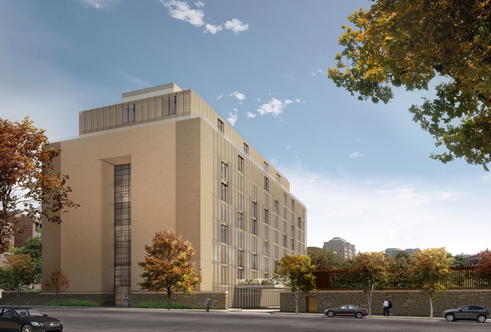Doubts Loom Over Heating Plant Demolition

By Elizabeth WienerCurrent Staff Writer
Though plans to demolish most of the West Heating Plant and build luxury condos in its place hit several hurdles at the Old Georgetown Board last week, the would-be developers insist that the increasingly controversial project will survive a gauntlet of government reviews.
Project representatives from the Levy Group and Georgetown Co. acknowledged that they may need a waiver from a covenant protecting the building to proceed with the amount of demolition currently proposed. But David Maloney, the D.C. state historic preservation officer who would have to issue such a waiver, told The Current that doing so would be “fundamentally inconsistent” with his office’s obligations under federal law.
And while several Old Georgetown Board members seemed open to the proposal at a hearing last Thursday, they insisted on getting an independent structural engineer’s report to document whether the 1948 building is so unstable it can’t be saved.
“This is a key issue and will continue to haunt us,” said chair David Cox. “It’s just due diligence [to determine] the magnitude of effort required to preserve it.”
The project’s own structural engineer described the long-vacant heating plant on 29th Street as essentially a brick shell, “misdesigned,” and so cracked, brittle and water-damaged that “there’s probably no way to fix it,” according to consultant Joel Silverman, who shared the report. “Any reputable structural engineer would say that wall has to come down — it’s not about adding windows, but basic structural safety.”
Further complicating the already complex proposal, the board also suggested that if the huge plant is in bad enough shape to justify demolition, it might make more sense to take the whole building down and come back with a new design.
“If you’re just keeping the front facade, you might as well take it all down,” said board member Stephen Muse.
Cox said the final product might be better “without the burden of the existing building.” Then he added, “If this site was empty, this board would never consider a 90-foot wall” facing the C&O Canal.
But total demolition would create yet another hurdle. Under zoning law, if parts of the plant are preserved, the structure would be considered “grandfathered” and could be rebuilt to its current 110-foot height. If it is razed to the ground, it’s unlikely that city officials would allow anything so big in that patch of Georgetown. And shrinking the project would cut into the profit margin.
Developer Richard Levy notes that his team has spent four years on the project so far, and it expects to overcome hurdles and eventually win approval for the 60- to 70-unit condo project, rebuilt to the same height and footprint as the former federal heating plant.
“In this context we’re long-distance runners, so one little stumble here and a misrepresentation there is not going to stop us,” Levy told The Current last week.
The proposal is in fact winning much praise, particularly because it would put a vacant and forbidding property to use, converting the walled grounds to parkland that will provide connections between Rock Creek Park and the Georgetown waterfront. But to do so, developers must work through a maze of preservation, zoning and financial issues.
Particularly thorny is the covenant which the U.S. General Services Administration attached to the deed when it sold the plant at auction last June. That covenant requires any development to comply with the U.S. secretary of the interior’s standards for treatment of historic properties.
And that means, said Rebecca Miller of the D.C. Preservation League, that any reuse plan can’t have an “adverse effect” on the heating plant, which is listed as a contributing structure in the Georgetown Historic District. All bidders were aware of the covenant, yet the Levy proposal “not even remotely conforms” to this standard, Miller told the board.
Maureen Dwyer, attorney for the Levy team, objected. The deed in fact includes a provision for modifying or waiving the covenant, she said, and there is precedent for doing so when “structural issues arise.” Dwyer added: “My client would not be on this property were it not for a clause that allows for a waiver.”
Yet Maloney, the state preservation officer, seems unlikely to grant one. In an email to The Current, he wrote that waivers for these kinds of federal preservation covenants “are extremely rare, even looking across the country.” Maloney described such a waiver as “fundamentally inconsistent with [his office’s] legal obligations” for the heating plant, as prescribed by the General Services Administration.
The Old Georgetown Board’s staff also raised objections, calling the plant “a monumental remnant of Georgetown’s industrial heritage” and suggesting that the “most responsible historic preservation approach would be to protect the overall integrity of the building, rather than to preserve only a fragment.”
But the board itself viewed the project from a different lens — design, not legalities. “We’re not opposed to contemporary architecture. The proposed building is very beautiful,” said Muse.
“It’s not our call to comment on the legality of demolition,” said Cox.
Board members made one point clear: All three found a proposed pedestrian bridge between the property and the Four Seasons Hotel, which will manage the new condos, unacceptable. A “private bridge over a public park” — the C&O Canal — won’t pass muster, Muse said.
This article appears in the Nov. 13 issue of The Georgetown Current newspaper.
